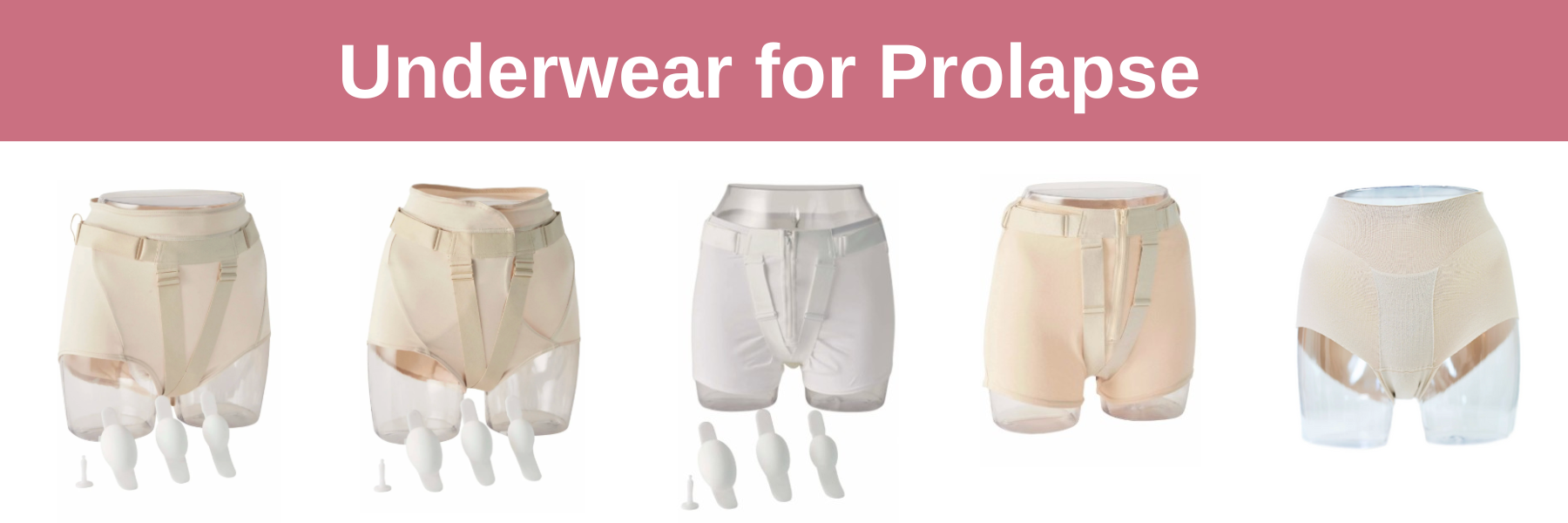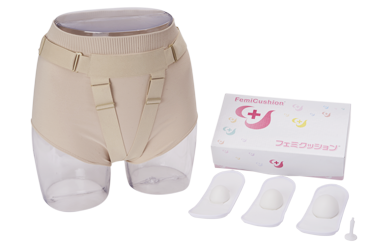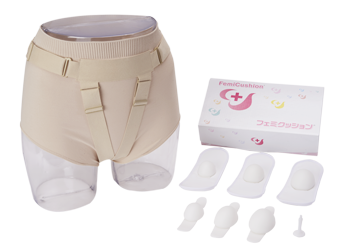
このページの監修医師

このページの監修医師
Uterine prolapse is a condition in which the uterus descends into the vagina and may even protrude outside the vaginal opening. This condition, along with the prolapse of other organs like the bladder, urethra, small intestine, and rectum, is sometimes referred to as “pelvic organ prolapse.”
As uterine prolapse progresses, it can lead to difficulties with urination and defecation, as well as sexual dysfunction. Pain and bleeding can make walking difficult, significantly impacting one’s quality of life (QOL). Furthermore, embarrassment may prevent women from seeking medical help or confiding in family and friends, leading to silent suffering. Many women wonder if there are ways to treat this condition at home without visiting a hospital.
This article introduces methods to alleviate uterine prolapse without hospital visits.
目次
Uterine prolapse occurs when the pelvic floor muscles, which support the pelvic organs, weaken or are damaged. The main causes include:
A major cause of uterine prolapse. During pregnancy, the uterus enlarges, and the vagina and pelvic floor muscles stretch and can be damaged during childbirth. Women who have given birth vaginally, especially those who have had three or more children or large babies, are at higher risk. It is said that 95% of women with pelvic organ prolapse have experienced childbirth.
Pelvic floor muscles weaken with age, increasing the risk of uterine prolapse. The decline in estrogen after menopause also plays a role.
Regular heavy lifting and other strenuous activities that increase abdominal pressure can contribute to uterine prolapse.
Obesity increases abdominal pressure and puts strain on the pelvic floor, raising the risk of uterine prolapse.
Coughing, sneezing, and straining during bowel movements increase abdominal pressure, which can contribute to uterine prolapse.
It is essential to consult a specialist in gynecology, urology, or urogynecology if you experience symptoms of uterine prolapse. While surgery is necessary for a complete cure, it carries risks. Therefore, many women opt for “conservative treatment” to alleviate symptoms without surgery. One commonly used device in conservative treatment is “FemiCushion.”
The choice between surgery and conservative treatment depends on individual lifestyle and the progression of the prolapse.

There are various surgical procedures available for uterine prolapse, and surgery is the only way to completely cure this condition. However, some procedures have a high recurrence rate. Transvaginal mesh surgery (TVM), in particular, carries risks such as mesh exposure, erosion, and infection, and this procedure has been completely discontinued in the United States and Europe.
For more information on pelvic organ prolapse surgery, please click here.
Conservative treatment aims to alleviate symptoms without surgical intervention. Many women choose this option due to concerns about the impact of surgery on pregnancy and sexual intercourse, the high cost of surgery, and the risk of recurrence.
Conservative treatment includes pelvic floor muscle training (Kegel exercises) and the use of medical devices like ring pessaries and FemiCushion.
Pelvic floor muscle training strengthens the muscles that support the uterus, bladder, urethra, small intestine, and rectum. These exercises are simple and can be done anywhere, anytime.
* Contract your pelvic floor muscles as if you are trying to stop urination.
* Hold the contraction for 5 seconds, then slowly release.
* Repeat this 10 times.
* Aim to do this exercise several times a day.
* **Lifestyle Changes:** Lose weight if you are overweight, improve bowel habits, and avoid heavy lifting to reduce abdominal pressure.
* **Improve Urination and Defecation Habits:** If you experience frequent urination or a feeling of incomplete emptying, review your urination habits. For constipation, consume more fiber and drink plenty of water.
* **Improve Posture:** Maintain good posture and avoid slouching.
* **Stress Reduction:** Since stress increases pelvic floor muscle tension, make time to relax.
* If your uterine prolapse symptoms are severe or do not improve with conservative treatment, surgery may be necessary.
* Self-treatment can be dangerous. Always consult a doctor for appropriate treatment.
The Japan Society of Pelvic Organ Prolapse: https://www.jspog.com/
This information is intended for general knowledge and is not a substitute for medical advice. Please consult a healthcare professional for any specific symptoms or treatment options.
If surgery is not an option due to complications or other reasons, a ring pessary is often the only choice offered in hospitals. This donut-shaped device is inserted into the vagina and requires hospital visits every 2-3 months for vaginal cleaning and ring replacement.
For more information about pessaries, please click here.
However, ring pessaries are not suitable for women who wish to become pregnant. Some women may also find them uncomfortable or unsuitable for other reasons. In such cases, FemiCushion, discussed below, is recommended.
Wearing specialized underwear that supports the prolapsed organs from the outside can be an effective treatment. This type of underwear holds the organs in place within the vagina and provides upward support to prevent them from descending again.
FemiCushion, a leading brand of underwear specifically designed for pelvic organ prolapse, can be worn by patients themselves. It is an excellent option for those who cannot make regular hospital visits, cannot undergo surgery immediately due to complications or financial reasons, or need support during periods when a ring pessary is removed. By wearing FemiCushion, the organs can be kept inside the body.
For more information about FemiCushion, click here. For information about medical devices for pelvic organ prolapse, click here.
*Flexible Wear:No need to wear it all day; it can be worn as needed, before the organs prolapse.
*Minimal Burden:It provides support for the organs in their reduced state within the vagina, minimizing strain on the organs and mucous membranes.
*Surgery Alternatives:Suitable for those who cannot undergo surgery due to complications and can be used while waiting for surgery or after removing a ring pessary.
*Hygienic:Washable and reusable, ensuring cleanliness.
*Insurance Coverage: FemiCushion is a medical device and may not be covered by health insurance. However, it may be eligible for medical expense deductions on tax returns and may be covered by medical assistance for those receiving public aid. Consult your caseworker for more information.
*Ease of Use:Some types are designed for easy removal for urination and defecation, including options with zippers.
*Proper Usage:Instructional videos are available to demonstrate how to use FemiCushion correctly.
While various treatment options exist beyond ring pessaries and pelvic floor muscle training, some may not be effective.
Girdles and corsets, often worn to increase abdominal pressure, flatten the stomach and lift the hips but do not apply tension to the groin area. This downward pressure can relax the pelvic floor muscles and worsen pelvic organ prolapse. To counter this downward pressure, upward support is necessary, which is not provided by commercially available garments.
After years of research, FemiCushion was developed to provide “soft support and hygiene” while “countering abdominal pressure and gently supporting the organs.”
Many patients who discover FemiCushion often express, “This is it!” after struggling with various methods to manage pelvic organ prolapse for years. FemiCushion offers the solution they have been seeking, with many saying, “This is exactly what I needed!”
If your uterus is consistently prolapsed, the descended organs can rub against your underwear or other materials, leading to irritation and bacterial infections. This can also result in poor blood circulation, pain, and further progression of the prolapse. Therefore, it’s crucial to keep the organs inside your body.
* Before using the restroom, wash your hands thoroughly.
* Gently grasp your uterus with two fingertips and push it upward towards your vagina.
* After repositioning, wearing FemiCushion can help keep the organs in place and prevent them from descending again.
With FemiCushion, you can exercise and lift objects without worrying about the prolapse recurring. However, avoid heavy lifting without support, as it can worsen uterine prolapse. Additionally, straining during bowel movements can exacerbate the condition, so it’s essential to prevent constipation.
*Practice Good Hygiene: Keep the area clean and dry to prevent infections.
*Avoid Activities That Increase Abdominal Pressure:** This includes heavy lifting, straining during bowel movements, and chronic coughing.
*Maintain a Healthy Weight:Losing weight can help reduce pressure on the pelvic floor.
*Do Kegel Exercises Regularly:These exercises strengthen the pelvic floor muscles and help support the organs.
*Consult a Doctor:If you have any concerns or experience complications, consult your doctor immediately.
Remember, it’s important to seek personalized advice and treatment options from your healthcare provider. This information is for general knowledge and should not be considered a substitute for professional medical advice.
Pelvic Floor Muscle Training is important to bring benefits to prevent some symptoms like prolapse or urine leakage.1 in 2 mothers experience leaks during coughing, sneezing, or exercise. Leakage is now quite common and widespread issue.
If the pelvic floor muscles weaken, it can not only lead to various female-related disorders but also cause lower back pain and poor posture.
Strengthening your pelvic floor muscles (PFMs) helps lift the vagina and support the proper alignment of internal organs.
You can use underwear to support your pelvic floor muscle training. FemiCushion Happiness is the garment to improve Pelvic Floor Weakness.
For details about FemiCushion-Happiness


永尾 光一 先生
一般社団法人日本精索静脈瘤協会 理事長
医療法人社団マイクロ会 理事長
銀座リプロ外科 院長
昭和大学にて形成外科学を8年間専攻。その後、東邦大学で泌尿器科学を専攻し、形成外科・泌尿器科両方の診療科部長を経験する(2つの基本領域専門医を取得)。得意分野はマイクロサージャリーをはじめとする生殖医学領域の形成外科的手術。泌尿器科医の枠を超えた細やかな手術手技と丁寧な診察で、様々な悩みを抱える患者さんから高い信頼と評価を得ている。

株式会社三井メディカルジャパン 代表取締役
三井 桂子
株式会社三井メディカルジャパン 代表取締役。日本における女性疾患についての認知や理解度の低さに危機感をおぼえ、医療機器開発に着手。子宮脱をはじめとする骨盤臓器脱の治療に用いる「フェミクッション」を開発し、三井メディカルジャパンを通じて発売。
目次1 三井社長についての質問2 フェミクッション開発経緯3 三井社長の想い4 フェミクッションの効果・優位性4.1 当社の提携医療機関5 今後の展望6 患者さんへのメッセージ 三井社長についての質問 本日は、三井メ…
続きを読む50代を迎えて精神的な不調や腟の違和感が表れ始め、「更年期症状ではないか」と不安を感じていませんか。 エストロゲン(女性ホルモン)低下は加齢といった原因で起こり、多くの女性がさまざまな症状を経験します。…
続きを読む「子宮脱のような症状があるけれど、何科を受診すれば良いかわからない」とお困りではありませんか。 近年、女性特有の悩みである子宮脱のような骨盤臓器脱を治療できる診療科が増えてきています。しかし、骨盤臓器…
続きを読むFemicushion™: UNICAMP – Urology Department – Campinas – Brazil 目次1 要旨1.1 導入と目的1.2 患者 […]
続きを読むスターターキット ライトネット購入限定

まずは試してみたい
という⽅に!
セット内容
・サポーター1枚(ミディベージュサポーター)
・クッション 3個(S・M・L各サイズ1個)
・布製ホルダー(フリーサイズ3枚)
・洗浄栓
※スターターキット ライトをご選択の方はミディベージュサポーターのみとなります。
スターターキット

普段の⽣活でしっかり
使いたい⽅に!
セット内容
・サポーター1枚(次の項目で種類・サイズを選択ください)
・クッション 6個(S・M・L各サイズ2個)
・布製ホルダー(フリーサイズ3枚)
・洗浄栓
※コットンの特注サイズは現在在庫切れです。